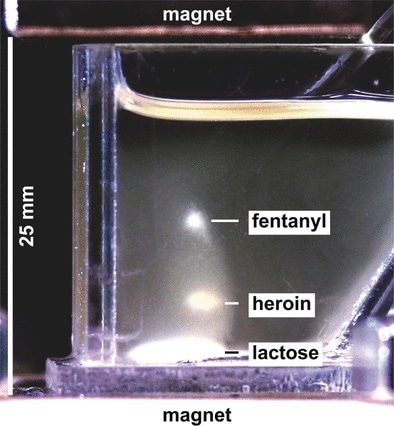The composition of suspicious powders that may contain illicit drugs can be analyzed using a quick and simple method called magneto-Archimedes levitation (MagLev), according to a new study published in the journal Angewandte Chemie. A team of scientists at Harvard University, USA, has developed the MagLev method to differentiate common street drugs in dilute mixtures. The method could complement or even replace other portable drug identification techniques, the scientists suggest.

Synthetic opioids—mainly fentanyl and its analogues—are a group of substances that were involved in 30,000 overdose-related fatalities in 2017 in the US alone. Law enforcement officers have to assess the contents of small samples of powders quickly and precisely, and cases of fentanyl detection are increasing in frequency. Sniffer dogs or colorimetric assays are relied on, which allow a rough but only qualitative analysis. However, an innovative, more complete analysis method has now been developed by the group of George M. Whitesides at Harvard University, in collaboration with colleagues from the Drug Enforcement Administration (DEA), Dulles, USA. Using MagLev, the scientists could easily separate and even isolate different drugs (as powders) from sample mixtures.
The MagLev device consists of two strong permanent magnets that flank a cuvette filled with a solution of a paramagnetic gadolinium chelate complex. When the scientists add a mixture of powdered drugs to the cuvette, the different substances in the mixture levitate; the powders wander and equilibrate at different heights in the cuvette that correspond to their characteristic density. Thus, the once homogeneous powder is divided into several levitating clouds, each one containing a relatively pure substance. The authors say they could separate up to seven test substances simultaneously. Among the substances that have been separated were prominent illicit drugs and adulterants found in mixtures, such as fentanyl, cocaine, heroin, lidocaine, caffeine, and methamphetamine.
For substance identification, the operator of the MagLev device compares the observed density of an unknown fraction with known densities of illicit drugs. However, the scientists also suggest that MagLev can be used as a preparative technique that separates and concentrates dilute substances, such as fentanyl, which might be present in a fraction of less than five percent by weight. In this case, the operator pipettes the fractionated components out of the cuvette, washes them with solvent, and dries them. Fractionation, and thus, concentration makes it easier to identify dilute drugs in mixtures using more selective but less sensitive techniques, such as FTIR or Raman spectroscopy, according to the authors.
Limitations of the technique are that the samples need to be separated as solid powders and should not dissolve in the paramagnetic solution, which contains gadolinium chelate complex and the nonpolar solvents hexane and tetrachloroethylene.
The authors of the study eventually hope to make the MagLev device commercially available to law-enforcement officers.
Source:
Journal reference:
Abrahamsson, C.K., et al. (2019) Analysis of Powders Containing Illicit Drugs Using Magnetic Levitation. Angewandte Chemie International Edition. doi.org/10.1002/anie.201910177.